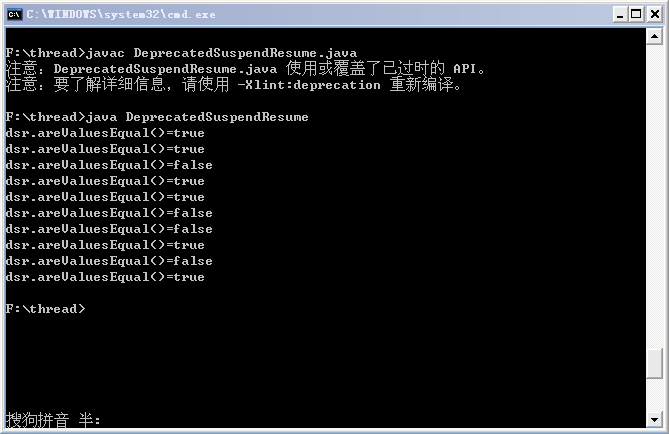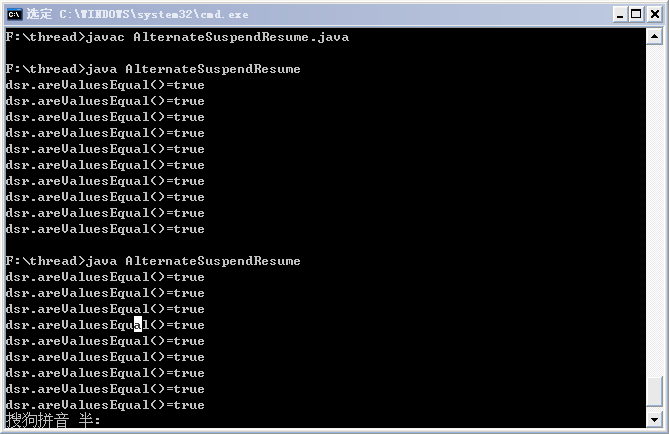挂起和恢复线程
Thread 的API中包含两个被淘汰的方法,它们用于临时挂起和重启某个线程,这些方法已经被淘汰,因为它们是不安全的,不稳定的。如果在不合适的时候挂起线程(比如,锁定共享资源时),此时便可能会发生死锁条件——其他线程在等待该线程释放锁,但该线程却被挂起了,便会发生死锁。另外,在长时间计算期间挂起线程也可能导致问题。
下面的代码演示了通过休眠来延缓运行,模拟长时间运行的情况,使线程更可能在不适当的时候被挂起:
public class DeprecatedSuspendResume extends Object implements Runnable{
//volatile关键字,表示该变量可能在被一个线程使用的同时,被另一个线程修改
private volatile int firstVal;
private volatile int secondVal;
//判断二者是否相等
public boolean areValuesEqual(){
return ( firstVal == secondVal);
}
public void run() {
try{
firstVal = 0;
secondVal = 0;
workMethod();
}catch(InterruptedException x){
System.out.println("interrupted while in workMethod()");
}
}
private void workMethod() throws InterruptedException {
int val = 1;
while (true){
stepOne(val);
stepTwo(val);
val++;
Thread.sleep(200); //再次循环钱休眠200毫秒
}
}
//赋值后,休眠300毫秒,从而使线程有机会在stepOne操作和stepTwo操作之间被挂起
private void stepOne(int newVal) throws InterruptedException{
firstVal = newVal;
Thread.sleep(300); //模拟长时间运行的情况
}
private void stepTwo(int newVal){
secondVal = newVal;
}
public static void main(String[] args){
DeprecatedSuspendResume dsr = new DeprecatedSuspendResume();
Thread t = new Thread(dsr);
t.start();
//休眠1秒,让其他线程有机会获得执行
try {
Thread.sleep(1000);}
catch(InterruptedException x){}
for (int i = 0; i < 10; i++){
//挂起线程
t.suspend();
System.out.println("dsr.areValuesEqual()=" + dsr.areValuesEqual());
//恢复线程
t.resume();
try{
//线程随机休眠0~2秒
Thread.sleep((long)(Math.random()*2000.0));
}catch(InterruptedException x){
//略
}
}
System.exit(0); //中断应用程序
}
}
某次运行结果如下:
从areValuesEqual()返回的值有时为true,有时为false。以上代码中,在设置firstVal之后,但在设置secondVal之前,挂起新线程会产生麻烦,此时输出的结果会为false(情况1),这段时间不适宜挂起线程,但因为线程不能控制何时调用它的suspend方法,所以这种情况是不可避免的。
当然,即使线程不被挂起(注释掉挂起和恢复线程的两行代码),如果在main线程中执行asr.areValuesEqual()进行比较时,恰逢stepOne操作执行完,而stepTwo操作还没执行,那么得到的结果同样可能是false(情况2)。
下面我们给出不用上述两个方法来实现线程挂起和恢复的策略——设置标志位。通过该方法实现线程的挂起和恢复有一个很好的地方,就是可以在线程的指定位置实现线程的挂起和恢复,而不用担心其不确定性。
对于上述代码的改进代码如下:
public class AlternateSuspendResume extends Object implements Runnable {
private volatile int firstVal;
private volatile int secondVal;
//增加标志位,用来实现线程的挂起和恢复
private volatile boolean suspended;
public boolean areValuesEqual() {
return ( firstVal == secondVal );
}
public void run() {
try {
suspended = false;
firstVal = 0;
secondVal = 0;
workMethod();
} catch ( InterruptedException x ) {
System.out.println("interrupted while in workMethod()");
}
}
private void workMethod() throws InterruptedException {
int val = 1;
while ( true ) {
//仅当贤臣挂起时,才运行这行代码
waitWhileSuspended();
stepOne(val);
stepTwo(val);
val++;
//仅当线程挂起时,才运行这行代码
waitWhileSuspended();
Thread.sleep(200);
}
}
private void stepOne(int newVal)
throws InterruptedException {
firstVal = newVal;
Thread.sleep(300);
}
private void stepTwo(int newVal) {
secondVal = newVal;
}
public void suspendRequest() {
suspended = true;
}
public void resumeRequest() {
suspended = false;
}
private void waitWhileSuspended()
throws InterruptedException {
//这是一个“繁忙等待”技术的示例。
//它是非等待条件改变的最佳途径,因为它会不断请求处理器周期地执行检查,
//更佳的技术是:使用Java的内置“通知-等待”机制
while ( suspended ) {
Thread.sleep(200);
}
}
public static void main(String[] args) {
AlternateSuspendResume asr =
new AlternateSuspendResume();
Thread t = new Thread(asr);
t.start();
//休眠1秒,让其他线程有机会获得执行
try { Thread.sleep(1000); }
catch ( InterruptedException x ) { }
for ( int i = 0; i < 10; i++ ) {
asr.suspendRequest();
//让线程有机会注意到挂起请求
//注意:这里休眠时间一定要大于
//stepOne操作对firstVal赋值后的休眠时间,即300ms,
//目的是为了防止在执行asr.areValuesEqual()进行比较时,
//恰逢stepOne操作执行完,而stepTwo操作还没执行
try { Thread.sleep(350); }
catch ( InterruptedException x ) { }
System.out.println("dsr.areValuesEqual()=" +
asr.areValuesEqual());
asr.resumeRequest();
try {
//线程随机休眠0~2秒
Thread.sleep(
( long ) (Math.random() * 2000.0) );
} catch ( InterruptedException x ) {
//略
}
}
System.exit(0); //退出应用程序
}
}
运行结果如下:
由结果可以看出,输出的所有结果均为true。首先,针对情况1(线程挂起的位置不确定),这里确定了线程挂起的位置,不会出现线程在stepOne操作和stepTwo操作之间挂起的情况;针对情况2(main线程中执行asr.areValuesEqual()进行比较时,恰逢stepOne操作执行完,而stepTwo操作还没执行),在发出挂起请求后,还没有执行asr.areValuesEqual()操作前,让main线程休眠450ms(>300ms),如果挂起请求发出时,新线程正执行到或即将执行到stepOne操作(如果在其前面的话,就会响应挂起请求,从而挂起线程),那么在stepTwo操作执行前,main线程的休眠还没结束,从而main线程休眠结束后执行asr.areValuesEqual()操作进行比较时,stepTwo操作已经执行完,因此也不会出现输出结果为false的情况。
可以将ars.suspendRequest()代码后的sleep代码去掉,或将休眠时间改为200(明显小于300即可)后,查看执行结果,会发现结果中依然会有出现false的情况。如下图所示:
总结:线程的挂起和恢复实现的正确方法是:通过设置标志位,让线程在安全的位置挂起
终止线程
当调用Thread的start()方法,执行完run()方法后,或在run()方法中return,线程便会自然消亡。另外Thread API中包含了一个stop()方法,可以突然终止线程。但它在JDK1.2后便被淘汰了,因为它可能导致数据对象的崩溃。一个问题是,当线程终止时,很少有机会执行清理工作;另一个问题是,当在某个线程上调用stop()方法时,线程释放它当前持有的所有锁,持有这些锁必定有某种合适的理由——也许是阻止其他线程访问尚未处于一致性状态的数据,突然释放锁可能使某些对象中的数据处于不一致状态,而且不会出现数据可能崩溃的任何警告。
终止线程的替代方法:同样是使用标志位,通过控制标志位来终止线程。


